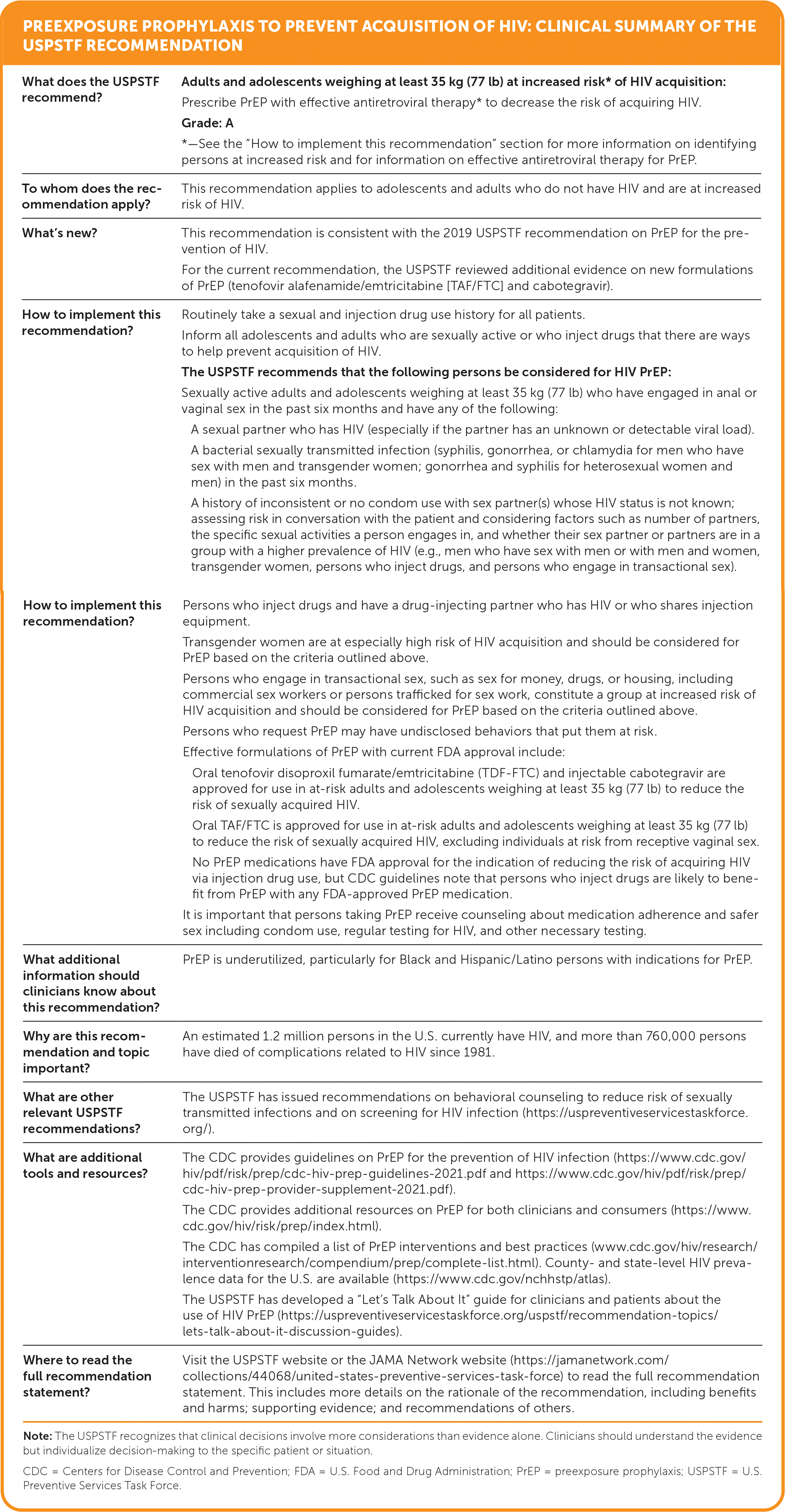
Am Fam Physician. 2023;108(6):online
Related Putting Prevention Into Practice: Preexposure Prophylaxis to Prevent Acquisition of HIV
As published by the USPSTF.

| What does the USPSTF recommend? | Adults and adolescents weighing at least 35 kg (77 lb) at increased risk* of HIV acquisition: Prescribe PrEP with effective antiretroviral therapy* to decrease the risk of acquiring HIV. Grade: A *—See the “How to implement this recommendation” section for more information on identifying persons at increased risk and for information on effective antiretroviral therapy for PrEP. |
| To whom does the recommendation apply? | This recommendation applies to adolescents and adults who do not have HIV and are at increased risk of HIV. |
| What’s new? | This recommendation is consistent with the 2019 USPSTF recommendation on PrEP for the prevention of HIV. For the current recommendation, the USPSTF reviewed additional evidence on new formulations of PrEP (tenofovir alafenamide/emtricitabine [TAF/FTC] and cabotegravir). |
| How to implement this recommendation? | Routinely take a sexual and injection drug use history for all patients. Inform all adolescents and adults who are sexually active or who inject drugs that there are ways to help prevent acquisition of HIV. The USPSTF recommends that the following persons be considered for HIV PrEP: Sexually active adults and adolescents weighing at least 35 kg (77 lb) who have engaged in anal or vaginal sex in the past six months and have any of the following: A sexual partner who has HIV (especially if the partner has an unknown or detectable viral load). A bacterial sexually transmitted infection (syphilis, gonorrhea, or chlamydia for men who have sex with men and transgender women; gonorrhea and syphilis for heterosexual women and men) in the past six months. A history of inconsistent or no condom use with sex partner(s) whose HIV status is not known; assessing risk in conversation with the patient and considering factors such as number of partners, the specific sexual activities a person engages in, and whether their sex partner or partners are in a group with a higher prevalence of HIV (e.g., men who have sex with men or with men and women, transgender women, persons who inject drugs, and persons who engage in transactional sex). |
| How to implement this recommendation? | Persons who inject drugs and have a drug-injecting partner who has HIV or who shares injection equipment. Transgender women are at especially high risk of HIV acquisition and should be considered for PrEP based on the criteria outlined above. Persons who engage in transactional sex, such as sex for money, drugs, or housing, including commercial sex workers or persons trafficked for sex work, constitute a group at increased risk of HIV acquisition and should be considered for PrEP based on the criteria outlined above. Persons who request PrEP may have undisclosed behaviors that put them at risk. Effective formulations of PrEP with current FDA approval include: Oral tenofovir disoproxil fumarate/emtricitabine (TDF-FTC) and injectable cabotegravir are approved for use in at-risk adults and adolescents weighing at least 35 kg (77 lb) to reduce the risk of sexually acquired HIV. Oral TAF/FTC is approved for use in at-risk adults and adolescents weighing at least 35 kg (77 lb) to reduce the risk of sexually acquired HIV, excluding individuals at risk from receptive vaginal sex. No PrEP medications have FDA approval for the indication of reducing the risk of acquiring HIV via injection drug use, but CDC guidelines note that persons who inject drugs are likely to benefit from PrEP with any FDA-approved PrEP medication. It is important that persons taking PrEP receive counseling about medication adherence and safer sex including condom use, regular testing for HIV, and other necessary testing. |
| What additional information should clinicians know about this recommendation? | PrEP is underutilized, particularly for Black and Hispanic/Latino persons with indications for PrEP. |
| Why are this recommendation and topic important? | An estimated 1.2 million persons in the U.S. currently have HIV, and more than 760,000 persons have died of complications related to HIV since 1981. |
| What are other relevant USPSTF recommendations? | The USPSTF has issued recommendations on behavioral counseling to reduce risk of sexually transmitted infections and on screening for HIV infection (https://uspreventiveservicestaskforce.org/). |
| What are additional tools and resources? | The CDC provides guidelines on PrEP for the prevention of HIV infection (https://www.cdc.gov/hiv/pdf/risk/prep/cdc-hiv-prep-guidelines-2021.pdf and https://www.cdc.gov/hiv/pdf/risk/prep/cdc-hiv-prep-provider-supplement-2021.pdf). The CDC provides additional resources on PrEP for both clinicians and consumers (https://www.cdc.gov/hiv/risk/prep/index.html). The CDC has compiled a list of PrEP interventions and best practices (www.cdc.gov/hiv/research/interventionresearch/compendium/prep/complete-list.html). County- and state-level HIV prevalence data for the U.S. are available (https://www.cdc.gov/nchhstp/atlas). The USPSTF has developed a “Let’s Talk About It” guide for clinicians and patients about the use of HIV PrEP (https://uspreventiveservicestaskforce.org/uspstf/recommendation-topics/lets-talk-about-it-discussion-guides). |
| Where to read the full recommendation statement? | Visit the USPSTF website or the JAMA Network website (https://jamanetwork.com/collections/44068/united-states-preventive-services-task-force) to read the full recommendation statement. This includes more details on the rationale of the recommendation, including benefits and harms; supporting evidence; and recommendations of others. |
The full recommendation statement is available at https://www.uspreventiveservicestaskforce.org/uspstf/recommendation/prevention-of-human-immunodeficiency-virus-hiv-infection-pre-exposure-prophylaxis.
The USPSTF recommendations are independent of the U.S. government. They do not represent the views of the Agency for Healthcare Research and Quality, the U.S. Department of Health and Human Services, or the U.S. Public Health Service.
